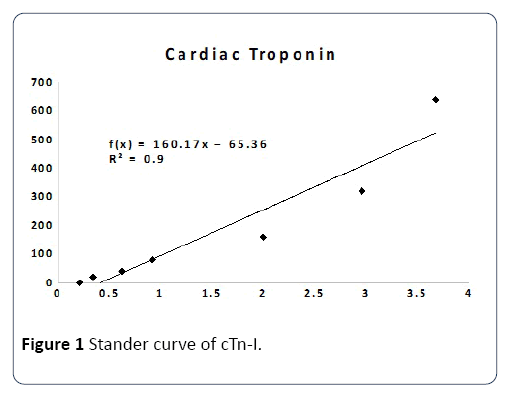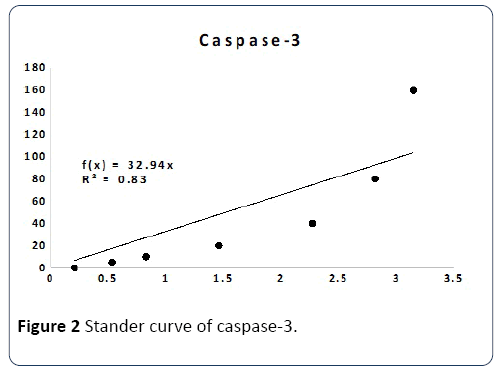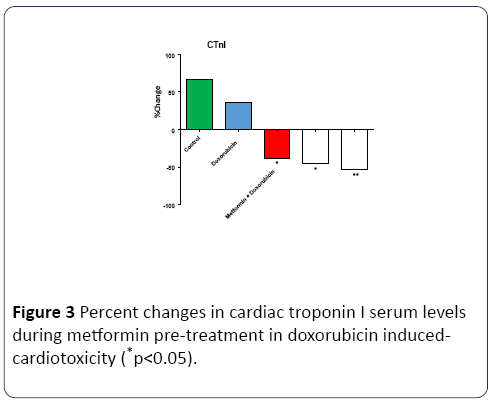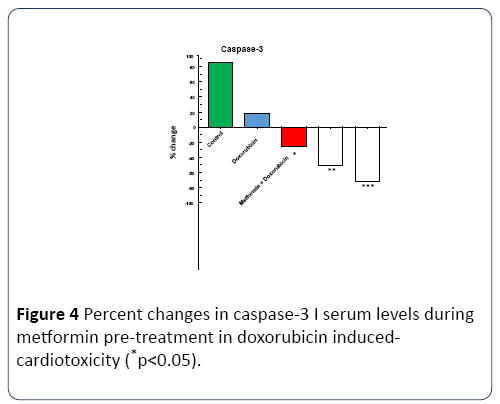Research Article - (2017) Volume 1, Issue 1
Hayder M Al-Kuraishy1* and Reem Ghanim Hussein2
1Department Of Pharmacology, Toxicology and Medicine, College of Medicine, Almustansiriya University, Iraq
2Department of Pharmacology, College of Pharmacy, Al-Yarmok University, Iraq
*Corresponding Author:
Hayder M Al-Kuraishy
Professor in Department of Pharmacology
Toxicology and Medicine, College of Medicine
Almustansiriya University, Iraq
Tel: +96407906230487
E-mail: Hayderm36@yahoo.com
Received Date: 31 October 2017; Accepted Date: 08 November 2017; Published Date: 15 November 2017
Citation: Al-Kuraishy HM, Hussein RG (2017) Caspase-3 Levels (CASP-3) in Doxorubicin Induced-Cardiotoxicity: Role of Metformin Pretreatment. Res J Oncol. Vol. 1 No 1: 4.
Copyright: © 2017 Al-Kuraishy HM, et al. This is an open-access article distributed under the terms of the creative Commons attribution License, which permits unrestricted use, distribution and reproduction in any medium, provided the original author and source are credited.
Background: The greatest danger of doxorubicin-induced toxicity is cardiotoxicity hence; administration of doxorubicin should be dose-limited. There are several biomarkers used to detect the cardiotoxicity which are cardiac troponin and caspase-3.
Aim: The aim of present study was assess caspase-3 serum levels in acute doxorubicin induced-cardiotoxicity in rats regarding the protective role of metformin.
Materials and methods: 18 Male Sprague Dawley rat were used in this experimental study. The rats were divided into three groups these were: Group Æ: Six rats as control group received normal saline 5 ml/kg/day intra-peritoneal for ten days. Group ÆÆ: Six rats treated with normal saline 5 ml/kg/day intra-peritoneal for ten days and doxorubicin 20 mg/kg was given as a single dose intra-peritoneal at 8th day. Group ÆÆÆ: Six rats treated with metformin 50 mg/kg/day orally via gavage for 10 days and doxorubicin 20 mg/kg was given as a single dose intra-peritoneal at 8th day. cTn-I serum level and caspase-3 serum level were assessed by specific ELISA kit method.
Results: Doxorubicin increase caspase-3 and cardiac Troponin I levels significantly p<0.01 compared to the control. Pre-treatment with metformin led to significant reduction in cTnI and caspase-3 serum levels compare to doxorubicin group p<0.05.
Conclusion: In doxorubicin induced-cardiotoxicity, caspase-3 is increased and regarded as a surrogate biomarker and pre-treatment with metformin produced significant cardio-protection in rats through reduction of caspase-3 serum levels.
Keywords
Doxorubicin; Cardiotoxicity; Caspase-3; Metformin
Introduction
The greatest danger of doxorubicin-induced toxicity is cardiotoxicity hence; administration of doxorubicin should be dose-limited. Patients are affected differently from acute to chronic cardiotoxicity [1].
Doxorubicin changes the structure and function of cardiomyocytes via change the genes that responsible for brain natriuretic peptide (BNP) and atrial natriuretic peptide (ANP) which are highly expressed in doxorubicin-induce cardiotoxicity that are responsible for cardiac hypertrophy [2].
The molecular mechanism behind this event involves formation of oxygen free radicals and iron oxidation. Since doxorubicin known to affect multiple biomarkers, the assessment of troponins and specific natriuretic peptides (pro BNP and DNP) is believed to predict doxorubicin-induced cardiotoxicity in early stages [3].
Doxorubicin-induced acute cardiotoxicity is a consequence from oxidative stress and free radical production which induced by doxorubicin that initiating oxidative myocardial injury. Furthermore, doxorubicin is converted by intracellular enzymes into semiquinone that generates the free radical [4].
The heart is the most susceptible organ to free radicals due to low activities of antioxidant enzyme thus; accumulation of free radicals will lead to lipid peroxidation, mitochondrial membrane damage, injury of nucleic acid and destruction of myocardium endoplasmic reticulum [5].
Changing level of mitochondrial protein and the increasing in NADH dehydrogenase can be caused by doxorubicin. Doxorubicin activates toll-like receptor 4 (TLR4), tumor necrosis factor-α (TNF-α) and reactive oxygen species (ROS). The apoptotic cascade will activate by cytochrome c which secreted from mitochondria due to increase in ROS level [6].
There are a several biomarkers used to detect the cardiotoxicity which are cardiac troponin, and caspase-3. Caspase-3 (CASP-3) protein is a member of the cysteineaspartic acid protease (caspase) family [7]. Normally, this protein is very necessary in brain development in addition to its classic role in apoptosis, also caspase-3 is responsible for chromatin condensation and DNA fragmentation. Elevated levels of caspase-3 in the bloodstream are a sign of myocardial infarction [8].
To reduce the cardiotoxicity dexrazoxane which is consider as a cardioprotive drug is the only drug that approved by FDA as a cardioprotectant drug against doxorubicin cardiotoxicity [9]. The use of beta-blocker seems to be protective against new onset cardiotoxicity or heart failure events due to the cardioprotective properties that improve the ventricular function and ejection fraction [10].
Felodipine has cardioprotective effect against doxorubicin's cardiotoxicity because it improves cardiac function and stops myocardial tissue damage by blocking the apoptotic pathways and myocardial caspase-3 activity. Felodipine preserve the normal cardiac morphology and histo-architecture [11,12].
Therefore, the aim of present study was assessment of caspase-3 serum levels in acute doxorubicin inducedcardiotoxicity in rats regarding the protective role of metformin pre-treatment.
Materials and Methods
A total number of 18 Male Sprague Dawley rat were used in this experimental study. Rats' age were ranged from 2-3 months with body weight ranged from 200-300 g. The animals were isolated as 6 rats in each cage with appropriate temperature and humidity and kept at artificial 12/12 light dark cycle. Free excess to chow pellets and water was permitted and left without intervention for period of one week for acclimatization. This experimental study was approved by Scientific Juries and Moral Committee of Animal Experimentation. Humane care for animals was done according to the guide to the care and use of laboratory animal.
After acclimatization, base line data of rat's weight was taken and then any rat with unwell looking or has infection was excluded. The rats were divided into three groups these are:
Group : Six rats as control group received normal saline 5 ml/kg/day intra-peritoneal for ten days.
Group : Six rats treated with normal saline 5 ml/kg/day intra-peritoneal for ten days and doxorubicin 20 mg/kg was given as a single dose intra-peritoneal at 8th day.
Group : Six rats treated with metformin 50 mg/kg/day orally via gavage for 10 days and doxorubicin 20 mg/kg was given as a single dose intra-peritoneal at 8th day.
The rats at 11th day were anesthetized using chloroform and the blood samples were collecting after a using sharp scissors for decapitation, (this method was intended to be painless, instantaneous and provide large amount of blood about 3-4 ml).
The blood was drained and allowed to flow to label EDTA containing tube with the aid of EDTA coated funnel. Then blood samples were centrifuged at 5000 rpm for ten minutes at room temperature. The formed supernatant layer was obtained as serum sample and stored in freezer at -20°C until time of analysis.
Assessment of cardiac troponin I, (cTn-I) serum levels
cTn-I serum level was assessed by ELISA-kit method (Rat Cardiac Troponin I, abx256152, Kono biotech Co.), the values were at ng/L. Standard curve was plotted (Figure 1).

Figure 1: Stander curve of cTn-I.
Assessment of caspase-3 serum levels
Caspase-3 serum level was assessed by ELISA-kit method (Rat Caspase-3, LS-F11016, Kono biotech Co.), the values were at μg/L. standard curve was plotted (Figure 2).

Figure 2: Stander curve of caspase-3.
Both kits were assessed according to the instruction of kit manufacturing company.
Statistical analysis
All data were expressed as the mean ± SD, Student’s unpaired t test was used to compare values between control and treated groups. A comparison of the results between the two groups was made by using the unpaired t-test. Two way ANOVA test was used to compare among three groups. Percent change (%) was calculated as a mean of delta change = (follow up value - baseline value)/baseline value × 100(%). P value was regarded significant when it <0.05.
Results
Doxorubicin increases caspase-3 serum levels and cardiac Troponin I significantly p<0.01 compared to the control (Table 1).
Table 1 The differences in the cardiac biomarkers in doxorubicin-induced cardiotoxicity compared to control.
| Parameters | Control (n=6) |
Doxorubicin (n=6) |
t | 95% CI | P |
|---|---|---|---|---|---|
| Caspase-3(μ/ L) | 2.75±1.08 | 18.00 ± 3.679 | 3.978 | 23.79-6.70 | 0.002 * |
| cTnI(ng/L) | 11.83± 2.52 | 35.33 ± 5.76 | 3.734 | -37.52-9.47 | 0.0039* |
Data are expressed as mean±SD,*p<0.01, cTnI: cardiac troponin
Effect of metformin on cardiac troponin I (cTnI) and caspase-3 serum levels
Doxorubicin causes significant elevation in cTnI and caspase-3 serum levels in doxorubicin group compared to control group. Regarding the pre-treatment with metformin there was a significant reduction in cTnI and caspase-3 serum levels compared to doxorubicin group p<0.05, (Table 2).
| Parameters | Doxorubicin(n=6) | Doxorubicin+metformin(n=6) | t | 95% CI | P |
|---|---|---|---|---|---|
| Caspase-3(μ/ L) | 18.00 ± 3.67 | 13.50 ± 2.64 | -2.43 | -8.99 | 0.03* |
| cTnI(ng/L) | 35.33 ± 5.76 | 21.83 ± 4.65 | -4.46 | -26.99 | 0.0012** |
Data are expressed as mean±SD,*p<0.05, **p<0.01 cTnI: cardiac troponin
Table 2 Effects of metformin pre-treatment on cardiac biomarkers in doxorubicin induced-cardiotoxicity.
The percent change following administration of metformin on cardiac troponin I serum levels showed significant decreased p<0.05 compared to doxorubicin group (Figure 3).

Figure 3: Percent changes in cardiac troponin I serum levels during metformin pre-treatment in doxorubicin inducedcardiotoxicity (*p<0.05).
The percent change following administration of metformin on caspase-3 serum levels showed significant decreased p<0.05 compare to doxorubicin group (Figure 4).

Figure 4: Percent changes in caspase-3 I serum levels during metformin pre-treatment in doxorubicin inducedcardiotoxicity (*p<0.05).
Discussion
Doxorubicin has a risky dose-dependent effect in the development of cardiomyopathy in up to 25% of patients and life-threatening heart failure in about 1-4%. Doxorubicininduced cardiotoxicity is linked with the cumulative dose of doxorubicin [13].
The present study showed that doxorubicin causes significant increase in serum levels of caspas-3 in doxorubicininduced cardiotoxity treated rats. Caspase-3 protein is a cystteine-aspartic protease which is activated in the apoptotic cells via death ligand leading to induction of apoptotic pathway. Caspase-3 protein is regarded as a biomarker of myocardial infarction and cardiac tissue toxicity [14].
The results of present study agree with Anghel et al. study that illustrated doxorubicin increase the level of caspase-3 and activate apoptosis by decrease the expression of antiapoptotic protein and induce oxidative stress by increasing hydrogen peroxide production [15].
Moreover, the present study showed that rats group which pre-treated with metformin has a significant decrease of serum caspase-3 level. Metformin has a cardioprotective effect via decrease the level of active form of caspase 3, cleaved caspase 3 and upregulates mitogen-activated kinase proteins p38 and extracellular signal-regulated protein kinases 1 and 2, which are considered as cardioprotective proteins [16,17]. Additionally, pretreatment with metformin significantly reduced the level of serum caspase-3 in rats due to its antioxidant, anti-inflammatory and anti-apoptotic properties [18].
The present study demonstrated that cardiac injury induced by doxorubicin during doxorubicin-induced cardiotoxicity presented though an elevation in serum levels of cardiac troponin I (cTnI) in doxorubicin treated rats since; doxorubicin cause a significant elevation in serum cardiac troponin I level. This increasing is due to oxidative stress induced-cardiotoxicity [19]. Also, the present study showed that metformin led to significant decrease in serum cardiac troponin I level. These findings are sustained by various studies that illustrated a significant decrease in cardiac troponin I level through activation of AMPK and stimulation of endothelial NO [20].
Hence, the cardioprotective effect of metformin may be due to different mechanism. Different studies gave an evidence and support that metformin has significant cardioprotective effects on cardiac ischemia in animal model studies via augmentation the tolerance to ischemic-reperfusion damage that is induced by reduction of adenosine monophosphate. Since, adenosine monophosphate is responsible for activation of phosphatidylinositol-3-kinase which activates nitric oxide synthase that prevent opening of mitochondrial transit pore (MTP) during cardiac ischemic-reperfusion injury. In addition, metformin attenuates doxorubicin induced-cardiotoxicity through activation of adenosine monophosphate activated protein kinase AMPK [21,22].
AMPK is responsible for regulation of cardiac metabolic pathway though regulation of anabolic and catabolic processes, it preserve of cardiac energy homeostasis. AMPK is regarded as cardiac sensitive sensor for cardiac stress for preservation of myocardial membrane potential. AMPK plays a potential role in mitochondrial protection through regulation of gene transcription and up-regulation of endogenous antioxidant system [23]. Metformin as well inhibits expression of pro-inflammatory enzyme like COX-2 and iNOS during doxorubicin cardiotoxicity with significant attenuation of proapoptotic pathway. All of these mechanisms may explain the ameliorative effect of metformin during doxorubicin cardiotoxicity in rats of the present study [24].
Conclusion
In doxorubicin induced-cardiotoxicity, caspase-3 is increased and regarded as a surrogate biomarker and pre-treatment with metformin produced significant cardio-protection in rats through reduction of caspase-3 serum levels.